Non-fatal injuries 9 Date 18 April 2014 Injuries 9 | Number of deaths 16 | |
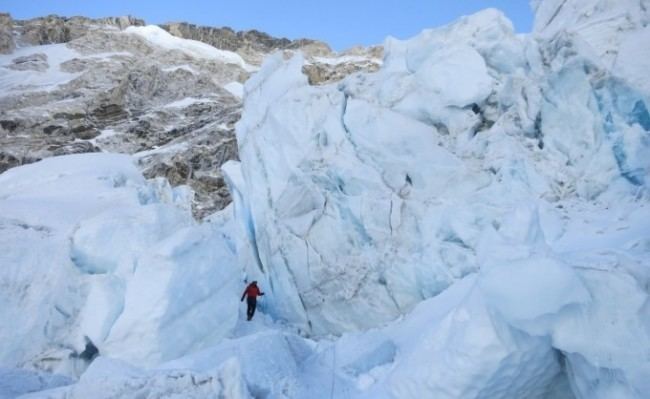 | ||
Time 06:45 local time (01:00 UTC) Similar 2015 Mount Everest a, 1996 Mount Everest di, April 2015 Nepal earthquake, 2014 Nepal snowstor, 1934 Nepal–Bihar earthquake Similar 2014 Nepal snowstorm disaster, 2015 Mount Everest avalanches, 1986 K2 disaster, 2008 K2 disaster | ||
On 18 April 2014, seracs on the western spur of Mount Everest failed, resulting in an ice avalanche that killed sixteen Nepalese guides in the Khumbu Icefall. This was the same icefall where the earlier 1970 Mount Everest disaster took place. Thirteen bodies were recovered within two days, while the remaining three were never recovered due to the great danger of performing such an expedition. Some Sherpa guides were angered by what they saw as the Nepalese government's meager offer of compensation to victims' families, and threatened a protest or strike. On 22 April, the Sherpas announced they would not work on Everest for the remainder of 2014 as a mark of respect for the victims.
Contents
- Guide employment on Mount Everest
- Concerns over Khumbu Icefall route
- Ice avalanche
- Victims
- Reactions
- Post disaster ascents in 2014
- Changes in 2015
- People killed at Everest
- References
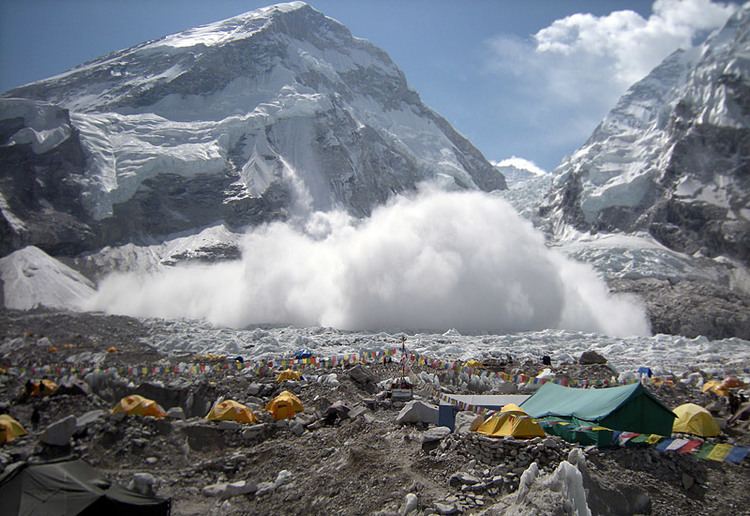
Guide employment on Mount Everest
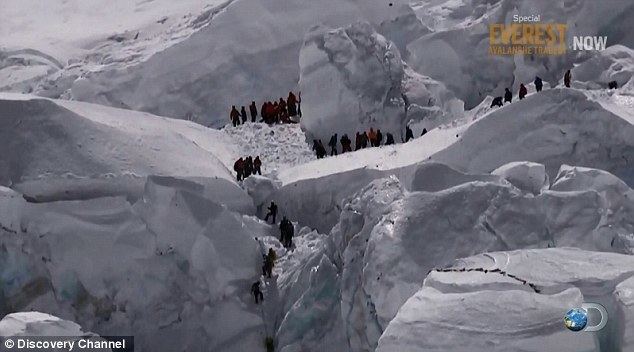
A Mount Everest guide typically earns about US$125/day per climb. Most come from climbing families, are raised on stories of wealth from climbs, with relatively few other economic opportunities. Between 350 and 450 guides, most of them Sherpas, work each year's climbing season. A guide can earn up to $5,000 a year, compared with Nepal's average annual salary of $700.
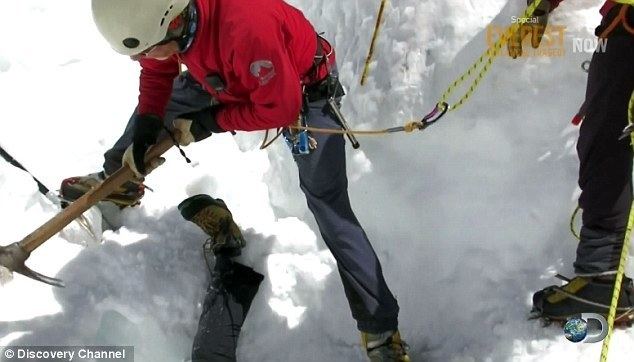
In the years prior to the disaster, foreigners began bringing their own guides, causing tension with locals. Eight people, including one of the most experienced Sherpa guides, died on Mount Everest in 2013.
Concerns over Khumbu Icefall route

The presence of numerous unstable blocks of ice (called seracs) in and above the Khumbu Icefall encourages climbers to try to pass through as quickly as possible, usually in early morning before temperatures rise and loosen the ice. In the spring of 2012 Russell Brice, of the guiding company Himex, called off guided ascents run by his company due to safety concerns. He was worried about the stability of a 300 metres (980 ft) wide ice cliff, or ice bulge, on Mount Everest's western shoulder that could endanger the route through the Khumbu Icefall, if it collapsed. "When I see around 50 people moving underneath the cliff at one time," he commented, "it scares me." However, Brice and Himex returned to the south side of Everest for the 2014 climbing season. Mountaineer Alan Arnette reported that this ice bulge had been a known hazard for years and had discharged ice into the Khumbu Icefall almost every season. He added that, "In 2012 it narrowly missed many climbers." According to writer and mountaineer Jon Krakauer, the 2014 ice avalanche was triggered when a block of ice "the size of a Beverly Hills mansion" broke off from the bulge.
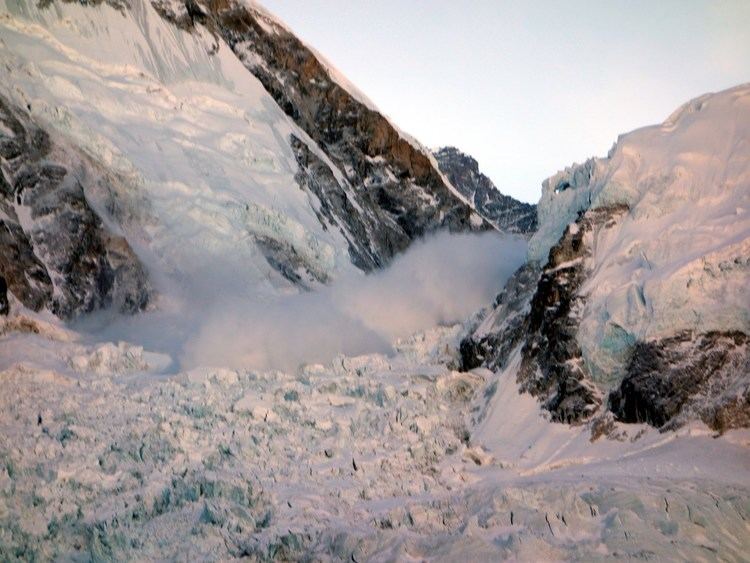
Conditions change regularly with the glacier's shifting ice, so climbing guides must find and maintain a new route through the icefall each season.
Ice avalanche
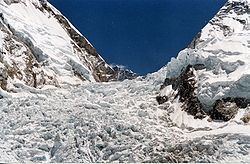
At approximately 06:45 local time (01:00 UTC,18 April 2014), an ice avalanche occurred on the southern side of Mount Everest, at an elevation of approximately 5,800 metres (19,000 ft). Twenty-five men, mostly Sherpa guides, were buried in the avalanche. The group was fixing ropes and preparing the South Col route for fee-paying climbers during the upcoming climbing season. The accident zone, locally known as "the Golden Gate" or "Popcorn Field", lies within the Khumbu Icefall. It is below the traditional site of Camp II, on the route between Camp I and Camp II.
The ice avalanche came from a large serac breaking off on the slopes of Mount Everest's western shoulder. Despite most reporting this was not an avalanche in the usual sense of the word as there was a little snow involved and the large blocks of serac ice behave much more like a rockfall. The serac was estimated to have been 34.5 meters (113 ft) thick and to have had a mass of 14.3 million kilograms (31.5 million pounds). Though there have been calls for construction of defensive structures, they are impossible on the scale necessary
Victims
Sixteen people died in the disaster. Thirteen bodies were recovered as of 48 hours later, when search and rescue operations were called off due to "too much risk". Three victims are still buried in roughly 80 to 100 metres (260 to 330 ft) of snow and ice. Nine other guides were also injured, including three who required intensive-care hospitalisation.
Four fatalities were Sherpas from Nepal's Solukhumbu District. Five were working for Discovery Channel, preparing for an upcoming special in which Joby Ogwyn was planning to attempt a BASE jump from the mountain. No foreigners were killed. According to mountaineer Tim Rippel, the victims were moving slowly and carrying large "loads of equipment, tents, stoves, oxygen and so on up to stock camps" when the avalanche occurred. The guides had started out in early morning but were delayed by poor climbing conditions. The second unit crew of disaster movie Everest (2015) were filming nearby, but suffered no injuries or fatalities; Sherpas involved with the film's production gave assistance after the avalanche. In total, the search and rescue team included nine Sherpas and three foreigners.
The 2014 disaster is the second-deadliest disaster in Everest's history, only superseded by avalanches that struck the southern side of the mountain the following year, on 25 April 2015, triggered by a magnitude 7.8 earthquake in Nepal.
Reactions
Rippel reported "everyone is shaken here at base camp". Some of the climbers immediately packed up their belongings and left.
In addition to mandatory insurance policies paying USD$10,000 to guides' families, the Nepalese government announced compensation of Nepali Rs. 40,000 ($400) each as immediate relief to the victims' next of kin. This government offering, which only covers funeral costs, angered Sherpas and was dismissed by the Nepal Mountaineering Association (NMA). The NMA announced they would stop work in seven days' time if compensation of US$10,000 were not paid to families of the dead, injured and missing. They further demanded a memorial to the dead, the doubling of insurance coverage to $20,000 and government payment of medical bills. According to unverified reports, 350 guides voted to suspend operations on Everest. Other reports said the guides agreed to unspecified "strong protests".
On 21 April, eight of the dead were ceremoniously driven through Kathmandu and then cremated in a Buddhist religious ceremony. On 22 April, the Sherpas announced they would not work on Everest for the rest of 2014 out of respect for the victims. Tulsi Gurung said: "We had a long meeting this afternoon and we decided to stop our climbing this year to honour our fallen brothers. All Sherpas are united in this." The fate of 334 climbing permits sold at $10,000 each is uncertain. By 24 April, almost all expeditions had decided to abandon their climbing plans; the 600 mountaineers who were at Base Camp before the avalanche was down to 40 or 50.
On 23 April, the Nepalese government announced it would give an additional 500,000 Nepali Rs. (approx. US$5,100) to the families of the dead climbers. Although these funds started to be paid in December 2014, it was reported in January 2015 that the bereaved Sherpa families were further angered because the money could only be obtained if they presented documentation in Kathmandu, which is impossible for many of those who live in the Khumbu region.
Discovery cancelled Ogwyn's planned BASE jump shortly after the ice avalanche struck, and announced it would broadcast a documentary about the tragedy. Entitled Everest Avalanche Tragedy, the 90-minute programme was shown on 4 May. The company also said it would make a donation to the American Himalayan Foundation Sherpa Family Fund, a charity supporting the families of those who died in the disaster.
Following the accident, the NMA president Ang Tsering Sherpa proposed installing avalanche-prevention barriers similar to those found above European ski resorts. He said: "We should ... adopt some precautionary measure – learning from [how] mountains [are managed] in developed countries where they adopt measures to avoid avalanches by putting some kind of wood or some concrete so that it helps make it safe.”. It is very doubtful however if any defensive structures are feasible for events of this size.
The 2015 documentary Sherpa explores reactions to the avalanche after filmmakers were on location when it occurred.
Post-disaster ascents in 2014
The first post-avalanche ascent of Mount Everest via the South Col route was on 23 May 2014, by the Chinese businesswoman Wang Jing, together with five Sherpas. Her ascent sparked controversy, as she bypassed the Khumbu Icefall by helicopter, which took her to 21,000 feet; this decision was made because the 2014 ropes and ladders had been removed. She made her ascent without new rope lines, and beyond the usual 2 PM cut-off time, and made her descent in the dark. Tamding Sherpa, the leader of the team that Wang was planning to use before her original expedition was called off as a result of the disaster, stated that he considered her ascent to be "cheating".
Changes in 2015
As a result of the dangers of the normal route up the left side of the icefall, the Nepali authorities announced in February 2015 that a new route, up the centre of the icefall, would be followed instead. According to the director of the Nepali government’s Department of Tourism, Tulasi Prasad Gautam, “In response to the last year’s avalanche we are trying to make Everest climbing a little safer by avoiding the old route.”
In addition, the insurance for each Sherpa in 2015 will be $15,000 rather than the previous $11,000.
People killed at Everest
It was widely reported 16 people died in the ice avalanche, in addition three more died that season for a total of 19.
Another listing:
- Mingma Nuru Sherpa
- Dorji Sherpa
- Ang Tshiri Sherpa
- Nima Sherpa
- Phurba Ongyal Sherpa
- Lakpa Tenjing Sherpa
- Chhiring Ongchu Sherpa
- Dorjee Khatri
- Then Dorjee Sherpa
- Phur Temba Sherpa
- Pasang Karma Sherpa
- Asman Tamang
Reported missing soon after disaster:
- Tenzing Chottar Sherpa
- Ankaji Sherpa
- Pem Tenji Sherpa
- Ash Bahadur Gurung.
Another listing
- Ang Kaji Sherpa
- Dorjee Sherpa
- Ang Chiring Sherpa
- Mingma Sherpa
- Ningma Sherpa
- Ang Kaji Sherpa
- Pasang Karma Sherpa
- Lakpa Tenzing Sherpa
- Chiring Wankchu Sherpa
- Wangele Sherpa
- Khem Dorjee Sherpa
- Furwa Temba Sherpa
- Aasamn Tamang Sherpa
Another listing:
- Mingma Tenzing Sherpa
- Aash Bahadur Gurung
- Dorje Khatri
- Ang Kazi Sherpa (aka "Ankaji")
- Ang Tshiri Sherpa
- Chhewang Sherpa
- Chhiring Ongchu Sherpa
- Dorje Sherpa
- Lhakpa Tenjing Sherpa
- Mingma Nuru Sherpa
- Nima Sherpa
- Pasang Karma Sherpa
- Pem Tenji Sherpa
- Phur Temba Sherpa
- Phurba Ongyal Sherpa
- Tenzing Chhotar Sherpa
- Thendorje (Thendu Dorje)
Also
